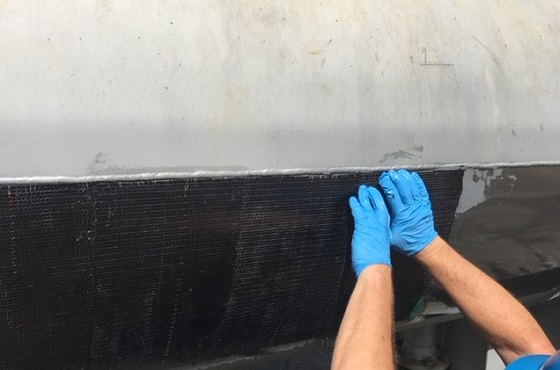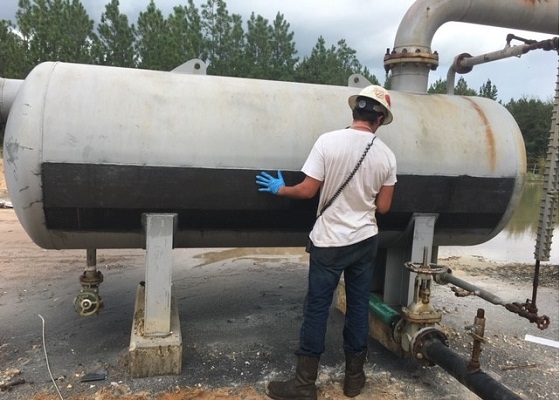About two years ago, the plant manager for an oil and gas operating company in Jay, Florida, USA, discovered three holes in the side of a sour crude oil tank while doing a routine inspection. The sense of urgency by officials at the Florida Panhandle plant, which wishes to remain anonymous, to repair the tank meant that a replacement couldn’t arrive quickly enough. That’s where composite repair materials manufacturer Belzona came into play.
“I had been working with [the manager] to show him some products that he might need some day,” says Kristin Kendrick, technical consultant at Belzona Florida. “He called me to see if we could do a Belzona SuperWrap II repair. Our consultants can train on-site employees to do many repairs, and that is how it was done for this job, since we needed to get it done quickly.”
Blasting Away Holes
The biggest reason the plant manager didn’t want to wait for a new tank was because he feared additional holes in the galvanized steel tank besides the first three. “He wanted to coat the entire fluids level of this 10-foot [3.0 m] tank, as he feared more damage,” Kendrick says of her client.
The tank was located in an open location, which meant there were no environmental concerns or access issues for the consultant and the plant maintenance crew. Personal protective equipment (PPE) requirements for the three plant workers included steel-toed boots, safety glasses, and hard hats, as well as ear plugs and respirators while blasting.
On the morning of the one-day repair, the crew grit blasted the tank with Black Beauty coal slag abrasive to achieve an average 3-mil (76.2 microns) profile and meet the NACE No. 2/Society for Protective Coatings (SSPC) Surface Preparation (SP) 10/Sa 2 ½ standard for “Near-White Metal Blast Cleaning.”
“Sure enough, after blasting, several more holes were evident,” Kendrick says. “We had anticipated this, so the owner was ready to apply the repair to the entire horizontal tank to rebuild it at the liquids level line.”
Afternoon Application
Blasting work was completed in the morning, while material application was done over about two hours on the afternoon of the same day. The application phase included mixing, due to technical features of the coating solution. “This is a two-part epoxy that sets up quickly, so all coating is mixed at the site,” Kendrick says. “Think of this as a reinforced coating system.”
Step one of application involved the installation of Belzona 1111 to thin areas that needed to be rebuilt. According to the manufacturer, the epoxy metal paste product is a solvent-free repair composite. The two-part epoxy resin is reinforced with silicon steel alloy that will not corrode and is resistant to a wide range of chemicals.
“It fills small holes and pits and generally reinforces weak metal and was applied at an average of 75–100 mils [1,905.0–2,540.0 microns],” Kendrick says, referring to dry film thickness (DFT). “The 1111 comes with a specialized Belzona plastic applicator that has one flat side like a scraper or squeegee, and other sides with different configurations for different substrates.”
Once the metal repair was in place, the next step was conditioning the entire application area with a coat of the Belzona 1982 SuperWrap II mixture, which consists of a resin and hardener.

“The 1982 is a very thin liquid when mixed, and we use it as a conditioner first applied with a brush,” Kendrick explains. “Then we pour a little stream of it on the length of carbon fiber, and spread it out with an applicator or brush. When it soaks in and turns dark, it is ready to apply. Contractors use their gloved hands to position it into place, and then we use paint rollers to gently squeeze out any air bubbles or excess resin.”
The SuperWrap II composite — which consists of the 1982 epoxy along with a carbon fiber wrap — was applied to all areas of the tank. According to the manufacturer, this repair solution is comprised of a fluid-grade resin system; a bespoke hybrid reinforcement sheet, based on fiber glass and carbon fiber; as well as release film to consolidate and finish off the application.
“The system was applied in two coats, one vertical, then the last one horizontal,” Kendrick says, adding that it was applied at approximately 125 mils (3,175.0 microns) DFT. “It is very substantial,” she said of the system thickness. “It’s very heavy duty.”
The applicators had good weather during the day, Kendrick recalled, with no interference to their planned operations. But Florida is known for its humid, tropical conditions, and one slight problem on this job was that rain was forecast for that night.
To prepare for imminent storms and allow the freshly coated areas to cure, the crew taped 6-mil (152.4 microns) plastic around the tank to protect it overnight. In all, the emergency repair required just a few hours of a single day for the applicators and consultant.

20-Year Plan
Thanks to the hard work of the crew and a reliable plan from the material manufacturer, the tank was ready to return to full service within 24 hours. “The tank was put back into service with little downtime, and it saved the customer a lot of money,” Kendrick said.
The on-site maintenance team took well to their training, with the manufacturer crediting them for their willingness to listen and learn. “I would give the crew 100 percent on their work,” the consultant recalled. “No problems at all.”
Entering 2020, their work continues to hold up after two years — even in the hot and humid conditions of the Florida Panhandle and the rigorous demands of an oil and gas operating environment.
“The application is still in place and performing very well,” Kendrick says. “This type of repair should last approximately 20 years. The customer is very happy, because there was not another tank available to replace this one when they found the
problem.”
Source: Belzona Florida, www.belzonaflorida.com
Reprinted with permission from CoatingsPro Magazine.